 Download Tutorial Lengkap (PDF 251 KB)
Download Tutorial Lengkap (PDF 251 KB)
AIRCRAFT CONTROL
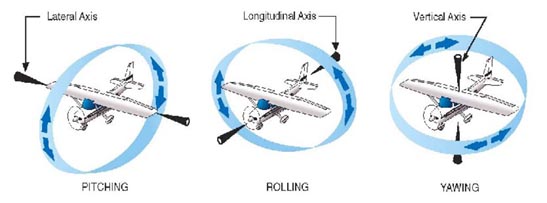
AXES OF AIRPLANE
An aircraft in flight is free to rotate in three dimensions:
- pitch, nose up or down about an axis running from wing to wing,
- yaw, nose left or right about an axis running up and down,
- roll, rotation about an axis running from nose to tail.
The axes are alternatively designated as lateral, vertical, and longitudinal. These axes move with the vehicle, and rotate relative to the Earth along with the craft. These definitions were analogously applied to spacecraft when the first manned spacecraft were designed in the late 1950s.
These rotations are produced by torques (or moments) about the principal axes. On an aircraft, these are produced by means of moving control surfaces, which vary the distribution of the net aerodynamic force about the vehicles center of gravity. Elevators (moving flaps on the horizontal tail) produce pitch, a rudder on the vertical tail produces yaw, and ailerons (moving flaps on the wings) produce roll.
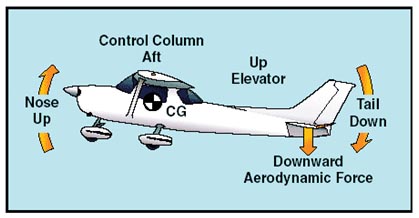
The lateral axis extends crosswise from wingtip to wing tip. Movement of the airplane around the lateral axis is known as pitch and is controlled by movement of the elevators. To effect a nose down attitude, the pilot pushes forward on the control wheel or stick. The elevator deflects downward, increasing the camber of the horizontal tail surface and thereby increasing the lift on the tail. To effect a nose up attitude of the airplane, the pilot pulls the wheel toward him. The elevators are deflected upwards decreasing the lift on the tail, with a resultant downward movement of the tail.
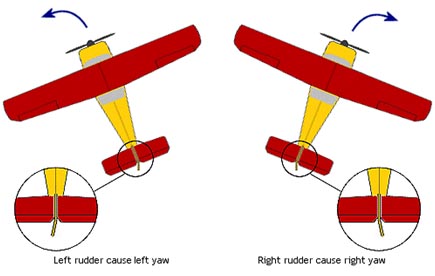
The vertical or normal axes passes vertically through the center of gravity. Movement of the airplane around the vertical axis is yaw and is controlled by movement of the rudder. Pressure applied to the left rudder pedal, for example deflects the rudder to the left into the airflow. The pressure of the airflow against the rudder pushes the tail to the right. The nose of the airplane yaws to the left.
There is a distinct relationship between movement around the vertical and longitudinal axes of an airplane (i.e. yaw and roll). When rudder is applied to effect a yaw, for example, to the right, the left wing (on the outside of the turn) moves faster than the inside wing, meets the relative airflow at a greater angle of attack and at greater speed and produces more lift.. The use of rudder, therefore, along with aileron can help to raise the wing and produce a better coordinated turn.
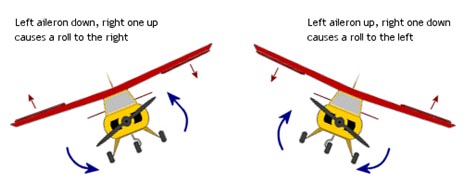
In a roll, the airplane has a tendency to yaw away from the intended direction of the turn. This tendency is the result of aileron drag and is called adverse yaw. The upgoing wing, as well as gaining more lift from the increased camber of the downgoing aileron, also experiences more induced drag. The airplane, as a result, skids outward on the turn. Use of rudder in the turn corrects this tendency.
2. AIRCRAFT CONTROL
Aircraft flight control allow a pilot to adjust and control the aircrafts flight attitude. The aircraft is controlled by deflection of flight control surfaces. These are hinged or movable surfaces with which the pilot adjusts the aircrafts attitude during takeoff, flight manoeuvring, and landing (aircraft attitude refers to whether the aircraft is pointing up, down, etc.). The flight control surfaces are operated by the pilot through connecting linkage to the rudder pedals and a control yoke.
2.1 Main Control Surfaces
The main control surfaces of a fixed-wing aircraft are attached to the airframe on hinges or tracks so they may move and thus deflect the air stream passing over them. This redirection of the air stream generates an unbalanced force to rotate the plane about the associated axis.
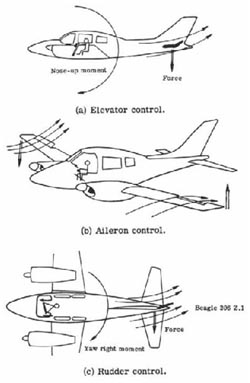
Ailerons
Ailerons are mounted on the trailing edge of each wing near the wingtips and move in opposite directions. When the pilot moves the stick left, or turns the wheel counter-clockwise, the left aileron goes up and the right aileron goes down. A raised aileron reduces lift on that wing and a lowered one increases lift, so moving the stick left causes the left wing to drop and the right wing to rise. This causes the aircraft to roll to the left and begin to turn to the left. Centering the stick returns the ailerons to neutral maintaining the bank angle. The aircraft will continue to turn until opposite aileron motion returns the bank angle to zero to fly straight.
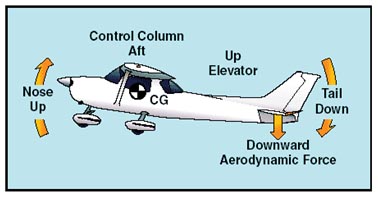
Elevator
An elevator is mounted on the trailing edge of the horizontal stabilizer on each side of the fin in the tail. They move up and down together. When the pilot pulls the stick backward, the elevators go up. Pushing the stick forward causes the elevators to go down. Raised elevators push down on the tail and cause the nose to pitch up. This makes the wings fly at a higher angle of attack, which generates more lift and more drag. Centering the stick returns the elevators to neutral and stops the change of pitch.
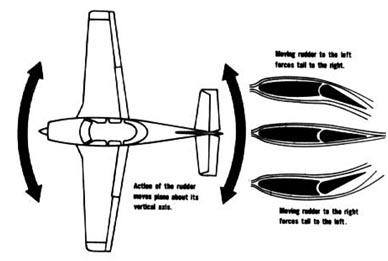
Rudder
The rudder is typically mounted on the trailing edge of the vertical stabilizer, part of the empennage. When the pilot pushes the left pedal, the rudder deflects left. Pushing the right pedal causes the rudder to deflect right. Deflecting the rudder right pushes the tail left and causes the nose to yaw to the right. Centering the rudder pedals returns the rudder to neutral and stops the yaw.
2.2 Secondary Controls Surfaces
Spoilers
On low drag aircraft like sailplanes, spoilers are used to disrupt airflow over the wing and greatly increase the amount of drag. This allows a glider pilot to lose altitude without gaining excessive airspeed. Spoilers are sometimes called "lift dumpers". Spoilers that can be used asymmetrically are called spoilerons and are able to affect an aircrafts roll.
Flaps
Flaps are mounted on the trailing edge of each wing on the inboard section of each wing (near the wing roots). They are deflected down to increase the effective curvature of the wing. Flaps raise the Maximum Lift Coefficient of the aircraft and therefore reduce its stalling speed. They are used during low speed, high angle of attack flight including take-off and descent for landing.
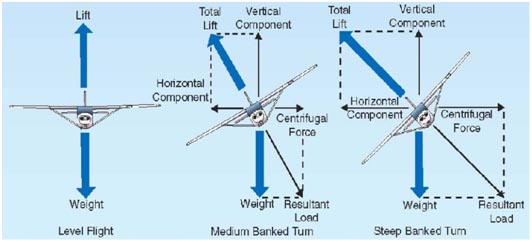
Slats
Slats, also known as leading edge devices, are extensions to the front of a wing for lift augmentation, and are intended to reduce the stalling speed by altering the airflow over the wing. Slats may be fixed or retractable - fixed slats to give excellent slow speed and STOL capabilities, but compromise higher speed performance. Retractable slats, as seen on most airliners, provide reduced stalling speed for take-off and landing, but are retracted for cruising.
Air brakes
Air brakes are used to increase drag. Spoilers might act as air breaks, but are not pure air breaks as they also function as lift-dumpers or in some cases as roll control surfaces. Air breaks are usually surfaces that deflect outwards from the fuselage (in most cases symmetrically on opposing sides) into the airstream in order to increase form-drag. As they are in most cases located elsewhere on the aircraft, they do not directly affect the lift generated by the wing. Their purpose is to slow down the aircraft. They are particularly useful when a high rate of descent is required or the aircraft needs to be retarded. They are common on high performance military aircraft as well as civilian aircraft, especially those lacking reverse thrust capability.
2.3 Other Controls Surfaces
Trim controls
Trimming controls allow a pilot to balance the lift and drag being produced by the wings and control surfaces over a wide range of load and airspeed. This reduces the effort required to adjust or maintain a desired flight attitude.
Elevator trim
Elevator trim balances the control force necessary to maintain the aerodynamic down force on the tail. Whilst carrying out certain flight exercises, a lot of trim could be required to maintain the desired angle of attack. This mainly applies to slow flight, where maintaining a nose-up attitude requires a lot of trim. Elevator trim is correlated with the speed of the airflow over the tail, thus airspeed changes to the aircraft require re-trimming.
Trimming tail plane
Except for very light aircraft, trim tabs on elevators are unable to provide the force and range of motion desired. To provide the appropriate trim force the entire horizontal tail plane is made adjustable in pitch. This allows the pilot to select exactly the right amount of positive or negative lift from the tail plane while reducing drag from the elevators.
Selamat Terbang...